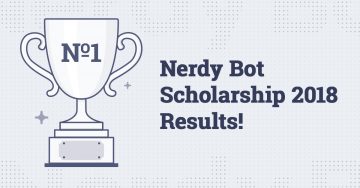-
August 23, 2018
Here is another blog post dedicated to Nerdify reviews of the most interesting and important stuff. This time we want you to meet Chelsey – one of our top Nerds. Hear her out.
Hello, I’m Chelsey. I decided to contribute into Nerdify Reviews topic to share my experience and help people who suffer from the phenomenon of “unhealthy perfectionism”. I see myself as a perfectionist, albeit an unhealthy one. I mentally criticize people (specifically new ones) who I think do not meet my standards or expectations.
I’m afraid of failure because I always want to be “perfect”. In school, I exert as much effort as I can in my exams. When the results are not in my favor, I would internally beat myself up for not getting the grade I desire. I tend to be overly cautious of taking risks, possibly rooted from my fear of failure. If I stay in my comfort zone, then nothing will happen.
I conducted a short research about perfectionism, and I’d say that (to an extent) I inhibit one of the main signs of a perfectionist. I’m not surprised; perfectionism does have harmful effects on my mental health.
What is Perfectionism?
Perfect means “… being entirely without fault or defect.” Now, if we look at Merriam-Webster’s definition of perfectionism, it means “… to regard anything short of perfection as unacceptable.”
In psychology, perfectionism in the psychological field means “… striving for flawlessness and setting high-performance standards….”
If they do not meet such standards, it would take a huge toll on their self-esteem and self-worth. On the same vein, unattained goals and standards would contribute to disappointment and unhappiness. Possibly, even depression.
Why is it a Toxic Trait?
People usually regard perfectionism as a “positive” trait. I’ve read articles that it is a cliché answer to the job question, “what is your weakness?”
Yes, it can be your weakness. But did you know perfectionism is more than that? Are you aware that it is toxic to your mental health and detrimental to your growth? For the curious soul, here are the reasons why:
You can’t bring yourself to commit mistakes or experience failure, for they make you believe you are incompetent. You have to be ready to face failure in order to be successful.
You don’t celebrate with pure joy and happiness. Instead, your success and achievements are met with scorn and self-criticism. Negative self-talk is what harms your happiness. You are too focused on the negative aspect of things.
You are afraid of being judged. You like other people to see you as a perfect human being (when in fact, you’re not). Perhaps you are hesitant in stating your flaws, as it may ruin your “perfect” self. There’s internal pressure involved too.
Apparently, these reasons are also correlated with the signs of perfectionism. Let us move on.
Five Signs of Perfectionism
1. Setting high (unrealistic) goals and standards
There’s nothing bad in establishing standards and not settling for anything less. It’s not even bad to have high goals. However, creating unrealistic standards and goals is unhealthy because they have to be realistic. Further, you are pressured to accomplish your goal no matter what. You may even have the tendency to expect that everyone has to abide by your… demanding and ultra-high standards. As said by Amy Morin, a psychotherapist. perfectionists are critical of people and expect them to be perfect as well.
2. Fear of failure/Making mistakes and staying within your comfort zone
You set a goal for yourself, but you are afraid of failure. In that regard, you are more inclined to focus on the end results (without fail) rather than enjoying the thrill and experience of achieving your goal. On the other hand, you refuse to move out of your “shell” because you don’t want to disappoint yourself (or anyone). Hence, you lean towards tasks you can do successfully—100% guaranteed. This brings more harm than good to your mental health and personal growth.
3. Trust issues
According to Elizabeth Lombardo Ph.D., perfectionists rarely delegate tasks because they think that their peers cannot do the job correctly. In practical settings, you don’t trust your colleagues enough if you want to assign them work. In the end, you do everything by yourself.
4. Low self-esteem and unhappiness
Let’s say you are angry with yourself because you failed to reach your goals. You immediately conclude you are inadequate and flawed. It can leave you a feeling of unhappiness and dissatisfaction. Kendra Cherry states that fear of failure is a sign of low self-esteem.
5. Negative self-talk and too critical
Perfectionists have the habit of finding faults in their achievements— no matter how small that is. You loathe yourself because you are not good enough. Therefore, your mind ends up being clouded with negative thoughts. You are also too critical of other people. Like I said, perfectionists highly expect their peers to be of “high standard” and “perfect”. This may push (or intimidate) people away. Unfortunately, it can lead to loneliness.
Overcoming Perfectionism: What Can You Do?
1. Accept the realities of life
Let’s do a reality check—you have to acknowledge that everyone, including you, makes mistakes in life. We fail in life— tests, interviews, work, assignments, and etc. At the end of the day, they push us to do better and improve ourselves. Just like everyone else, you have flaws. Don’t expect people to be exactly like you. Every individual is different. 2
2. Take on the challenge
Risk-taking is hard, as we do not know what is beyond the abyss of the unknown. If you are eyeing an activity that you’ve always wanted to try, go on ahead… don’t be afraid of failure and mistakes. Let go, and experience the “challenge” in all its glory.
3. Be open to learning
We have to reskill to cater to the demands of the 21st century. Skills are also a plus point in the workforce. When you are learning, always remember that everyone starts out as a noob or a newbie.
4. Set realistic goals and standards
Be grounded in reality! It’s fine to have high standards, but they have to be realistic. Use your standards as a guide or a framework, rather as an absolute ideal. Also, make your goals feasible (Remember SMART?). Again, don’t let failure bring you down. Failure does not mean that you are garbage, and it does not define who you are. As said by Oscar the Grouch, “just because you’re trash doesn’t mean you can’t do great things. It is called garbage can, not garbage cannot.”
Don’t forget to reward yourself if you achieved something big or small. Bring nothing but good vibes ☺
5. Learn to trust and delegate tasks
This is a leap of fate you must take. If you are overwhelmed, don’t hesitate to ask your colleague for assistance. You have to learn to understand and work with your peers. Bear in mind that you can’t do everything by yourself all the time.
After reading about perfectionism, I realized that I need to work on myself. I’d say that it was an eye-opening experience. Perfectionism is embedded in my psyche, and it will be a challenge to completely get rid of it. I hope this article has made you reflect on yourself.
How about you? Do you consider yourself as a perfectionist?
xoxo, Chelsey
More Nerdify reviews to come, stay tuned!
-
March 26, 2018
The mission of Nerdify has always been helping students to achieve more during their academic years at College or University. However, apart from helping students from all over the world, Nerdify is pioneering a new way to advance education through technology (Nerdy Bot Scholarship Competition is a great example of that).
On September 6th, 2016 Nerdify has launched one of the first AI educational bot for Facebook Messenger on ProductHunt – NerdyBot. The launch was a massive success – NerdyBot became a product of the year and won a Golden Kitty from ProductHunt.
We’ve decided to expand our success with Nerdybot and, on January 1st, 2018, launched a Nerdybot Scholarship – a worldwide competition, where any student could submit a 500-word essay on the following topic – “How can Artificial Intelligence help you with your studies?”
Students had 2 months to submit their essays (last day was on February 28th, 2018) and top 3 essays would get the following rewards – $1000, $600, $400 respectively.
We’ve been amazed by the number of essays we’ve got from you, guys! More than 1000 submissions from all over the world (and we mean literally from all over the world, just check out the countries we’ve had submissions from USA, Canada, Brazil, UK, Australia, South Korea, Spain, France, Bulgaria, Hungary, Uganda, Nigeria, India, Philippines, Romania, Ghana, Barbados, Netherlands, Vietnam)
We are so very grateful to each and every one of you. Seeing that level of participation, is really what keeps Nerdify team pushing the boundaries of education 🙂
Today we are going to announce the winners of the Nerdy Bot Scholarship Competition! 🙂
And the winners are……
First Place: Dora M. Donnelly (USA).
Second Place: Marisa Araujo Goncalves (Brazil).
Third Place: Zeeshan Azhar Sankaran (India).
We would like to congratulate our winners that have done an amazing job and we would also like to share with you our winner’s essay: “Nerdy Bot Scholarship Essay by Dora M. Donnelly”
A few words about our winner: Dora is a Bachelor student in US pursuing a Nursing degree. We’ve conducted a very short interview with the winner:
- Dora, tell us 2-3 interesting facts about yourself?
- I am an avid traveler – love visiting other countries and studying different cultures
- I love technology – it’s amazing to me, how it keeps on changing the lives of ordinary people
- I am a foodie, so I love cooking and trying different cuisines 🙂
- What is your dream?
- My dream is to become a Nurse and later on open up my own practice. I really love helping other people, this is what makes me wake up every morning 🙂
- Where will you spend $1000 scholarship?
- I strongly believe that education is an essential part of a one’s personal development. Therefore I will allocate my prize money towards my sister’s education. She is only 12 now, but it’s important to start saving up as early as possible, since education is very expensive in the US (I am looking forward to see how tech companies will disrupt the conventional education industry by offering affordable, good quality education to the mass market).
We were very impressed by Dora, such an inspiring student 🙂
We would like to congratulate all participants and thank them for taking part in our Nerdy Bot Scholarship competition. All winners should receive their winnings within the next 5 business days.
Follow us on Twitter and Facebook and stay tuned! There will be more challenges and competitions that you can participate in, later this year!
-
December 29, 2017
It’s been a hell of a year for Nerdify. We’ve helped a record number of students this year and we’ve doubled in size (hooray!). But the New Year is on the horizon… Which brings us to the question of how we can celebrate it? Certainly, most of us will be celebrating it with our friends and family, but what if you want to do something special this year?
We’ve created a list of five creative ways how you can celebrate this New Year, check it out, maybe there’s something in this list that you may wanna try 😉1. Visit real Santa
That means going to Finland. Yes, that’s not exactly a half an hour ride from your house, but bear with me, there are lots of awesome things you can do once you get there.
Finland has a fantastic national travel-website that has already collected all the main adventures Finland is famous about:
* You can go on a husky ride through the snowy forest (one of our Nerds actually did that – said it’s super cold, so make sure you bring warm clothes and some vodka with you. You gonna need it).
* You can check out beautiful auroras in the night sky (those are free of charge, thank you solar winds, yay!)
* You can go Gold panning (this is a perfect activity for kids – they get to collect their own GOLD, how cool is that?!).
* Cruise on an Icebreaker (and see real polar bears on little icebergs, oh… so cute 🙂
* And, obviously – see the real Santa Claus (that’s what New Year is all about, right?)
And much more actually. In Finland, you truly feel special during the New Year. You indeed think that miracles can happen during this special night, it’s absolutely magical.2. Celebrate New Year following traditions from another country.
Just a few examples for you, of the crazy shenanigans people do across the world during the New Years Eve:
* In Burma people splash buckets of water on each other to “start New Year with a clean soul”. They certainly can do that in Burma, because it is quite hot during the New Year. I suspect that wouldn’t really work somewhere in Canada, now would it? 😉
* In Russia, people write their wishes on a piece of paper, then set it on fire in a glass. When only ashes remain – they pour champagne into the glass and drink it “bottoms up” before midnight. That way your wish will come true in the following year. For additional tips on how to “Party Like a Russian” we suggest you check out the Robbie Williams video-guide.
* In Italy, Argentina and Bolivia it is a common tradition to wear colorful underwear. It is believed that it will bring luck, love and prosperity to the one who’s wearing either red, pink or yellow underwear 🙂 What can we say, those folks are definitely not boring 🙂
* In South Africa and Peru, people tend to get more violent. In Johannesburg, South Africa, it is common to throw old appliances out of the window. That way locals “step into the new year leaving old things behind”. While in Peru it is common to have a fist fight with a person you have a grudge on. That way you can “wipe the slate clean” before the New Year.Just make sure none of these local traditions get you in jail. As far as we can tell, no country has a tradition celebrating New Year’s Eve in jail 🙂
3. Be real Santa Claus.
Why not create some miracles yourself? You can be the master of the night by putting on a Santa Claus costume and grabbing a red bag full of goodies. Better still – gather a group of like-minded crazy people who will do a flash mob of Santas in the center of the city. You can build a huge snowman and give away presents and sweets to passers-by or baking a cookie that’s gonna crush the Guinness world record. Let your imagination go wild!
4. Outdoors
Being outdoors on the New Year’s Eve is also exciting. Imagine skiing in the mountains during the night.. Isn’t it magical? Alternatively, you can go full bananas and go camping in the forest. Greeting the New Year under the stars with a glass of champagne and a loved one. Romantic… but also quite chilly so make sure you have a heating pad with you or something. Getting a cold is not part of the plan here!
5. Do some charity-work
New Year is also a great time to think about those who are less fortunate than we are. What kind of a miracle would it be, if you could dress as a Santa and visit a local orphanage and give presents or sweets to the ones in need. Donate to the homeless shelter. Or visit a local animal shelter and adopt a puppy.
Remember, New Year is the time of miracles. It’s the only time when the whole world is celebrating, so why not do something special this time? 😉
Nerdify will be back with you next year to continue doing what it does best – helping students achieve their academic goals all across the world. Merry Christmas and a Happy New year to you!







